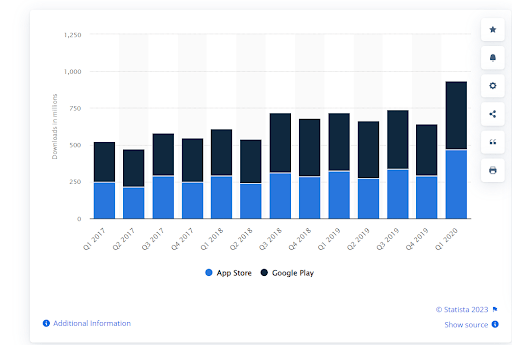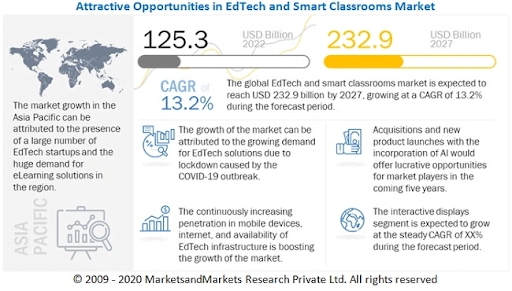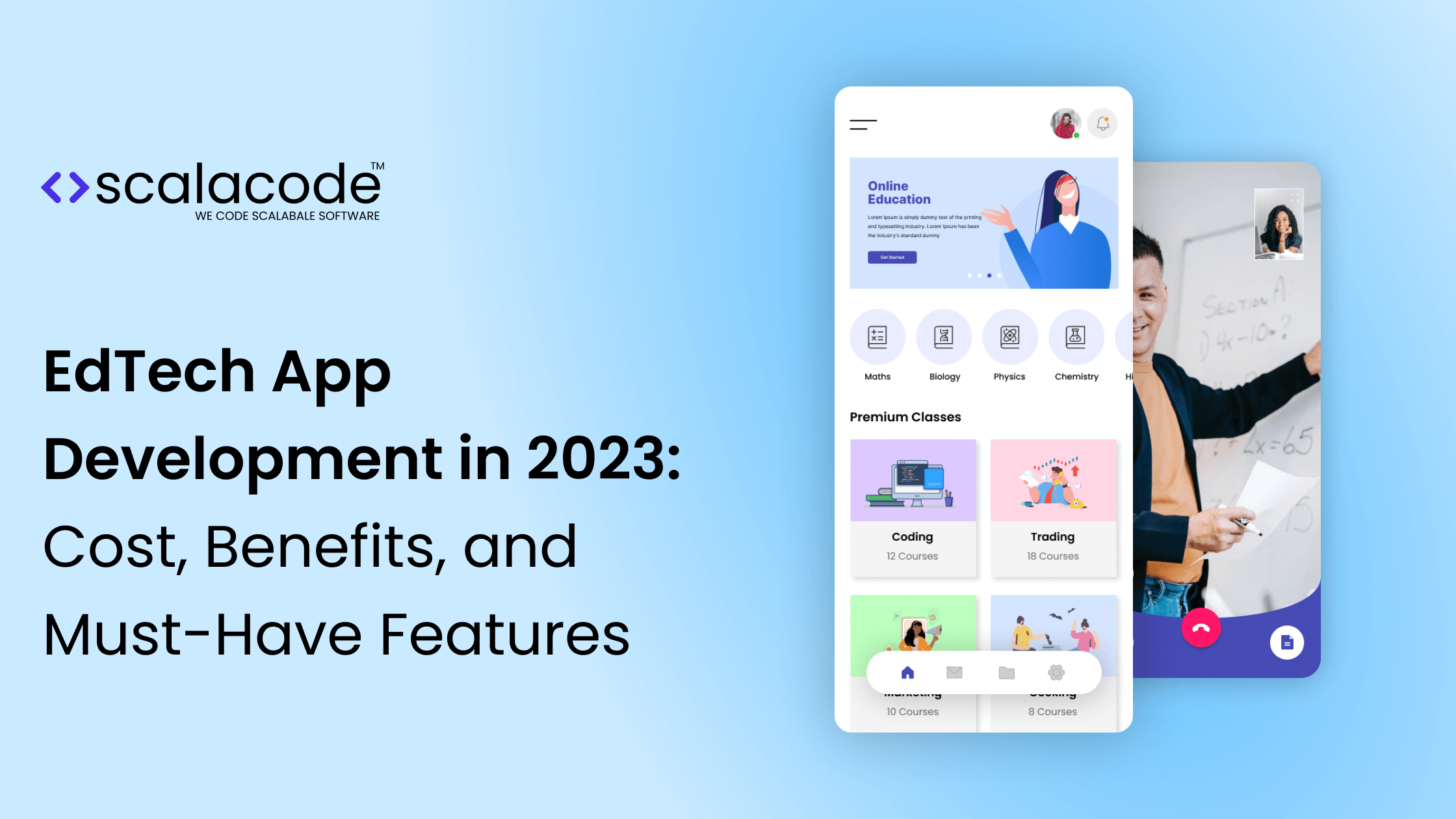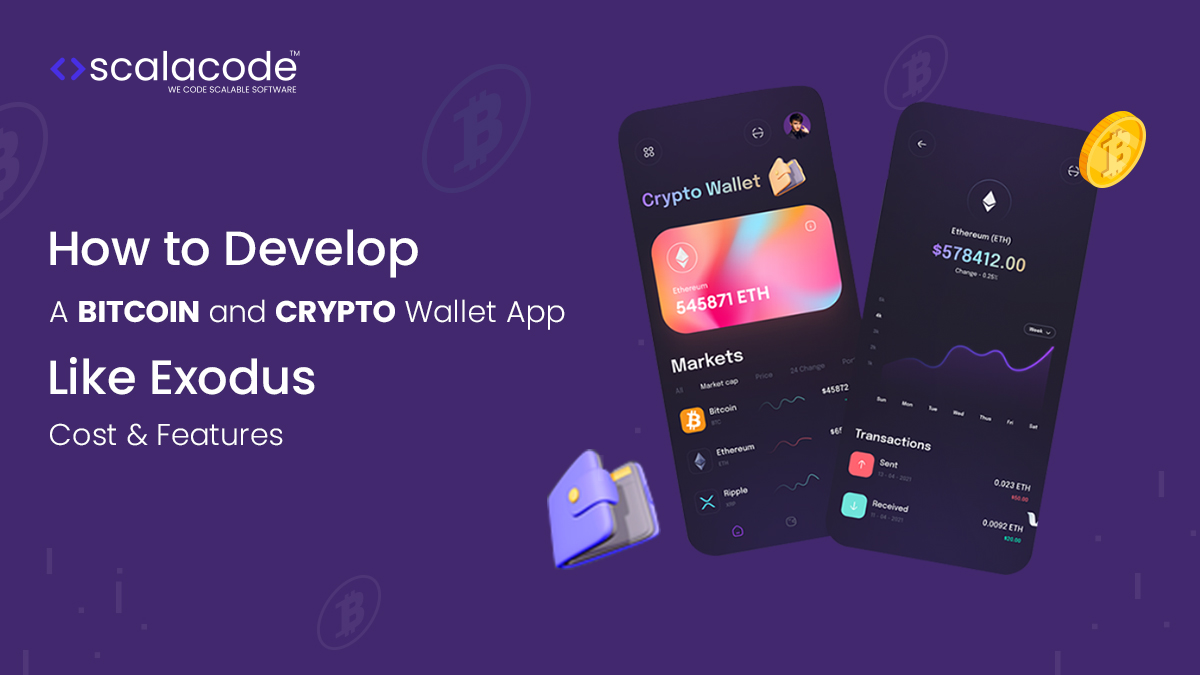Education has come a long way from the days of chalkboards to modern-day technologies like educational apps. All ages of students now have access to digital materials that improve their educational opportunities.
Such technological advancements are helpful to instructors, parents, and even the administration of the school, in addition to students.
The COVID-19 pandemic also brought a new dawn for educational apps, with many students relying on them to study remotely. As per a Statista report, the COVID-19 pandemic caused a surge in educational app downloads in the first quarter of 2020, with the Apple App Store having 470 million downloads and Google Play having 466 million downloads.

It’s an absolute jungle out there in the world of educational applications, with competition reaching cut-throat levels due to the insatiable demand for them.
But this begs the question of how much it really does cost to create an edTech application.
Well, by talking with the app development experts, we see that the cost somewhere lies between $20,000 and $35,000 to build a simple educational app. They also note that this is simply an average number, though.
The actual cost of an educational app greatly depends on client requirements.
For example, one client asked us to develop a simple app with a few features, like just an attendance record. While another client asks to develop an AI-based educational app for stuff like smart classrooms, online tutoring, and so on.
Comparing both scenarios, the cost of building an AI-based educational app is high compared to a simple attendance recording app. Why? Several factors influence the overall cost. One such factor is the complexity of the app.
| Complexity | Average Cost |
| Simple educational app | $20, 000-$35, 000 |
| Middle educational app | $35, 000-$50, 000 |
| Advanced educational app | $50,000 – $75, 000 |
We will discuss more what factors influence the cost of developing an ed-tech app. But before that, let’s define what an ed-tech app is and what market size it holds.
What is an EdTech app?
EdTech, or educational technology, has been recognized as a key tool in fostering learning and boosting its success. Its presence is omnipresent, ranging from digital tablets used in classrooms to whiteboards, e-learning sites, and even apps.
The purpose of EdTech applications is to provide a helping hand to learners and amplify the educational process both in groups and independently.
With these apps, learners can take advantage of entertaining interactive content, exercises, and tutorials to help them reach their educational ambitions. Moreover, EdTech tools enable instructors to come up with imaginative lesson plans for offering individualized learning experiences.
An Overview of the EdTech Market
When investing in any project, a businessperson must have a clear understanding of the market size. Because it is your money, you should avoid investing it in anything that will not yield rewards.
I hope this makes sense. Usually, market analysis is the first step in any type of app development project. The future is difficult to foretell, but by taking this step, educated judgments can be formed based on the market and recent trends.
We have listed some of the statistics that will help you understand this market:
According to a report by Markets and Markets, the EdTech industry is anticipated to reach a massive USD 232.9 billion by 2027. And this will be at a remarkable compound annual growth rate (CAGR) of 13.2%!

Some of the major players in the ed-tech app market include Duolingo, Khan Academy, and Quizlet, but many others are catering to various educational needs.
If you don’t want to fail at the first step, read this. Reasons Why Edtech Startups Fail and Ways to Overcome Them: An Overview
Understanding the Target Audience of EdTech Apps
- From young children to college students, students of all ages
- Parents looking for supplemental educational resources for their children
- Teachers and educators who want to enhance their teaching materials
- Homeschoolers who want a comprehensive learning experience
- Professionals seeking to expand their knowledge or skills in a certain subject
- NGOs and non-profit institutions provide educational resources and programs. For its students, educational institutions including schools, universities, and libraries offer educational resources.
The Benefits of EdTech Apps
Educational apps are not just trendy; they are highly beneficial for students and teachers alike. Here are at least six benefits of using educational apps:
- Interactive Learning Experience:
The biggest advantage of educational apps is their ability to make learning interactive. With features like animations, quizzes, and videos, students can actively engage with the content and retain it better.
- Personalized Learning:
Each student has a distinct way of learning, and these applications allow them to advance through the material at their own pace while receiving customized feedback.
- Accessible Learning:
With an educational app, students can learn anytime and anywhere. A mobile smartphone and an internet connection are all they require. Educational apps have made learning accessible and convenient for students of all ages.
- Real-time feedback:
Students can track their progress and find areas for growth with the use of educational applications that can give them real-time feedback. Students are inspired to perform better thanks to the quick response.
- Gamification of Learning:
Learning can be made more enjoyable through the use of educational apps that integrate gaming features. Incorporating competitive components and self-challenging tasks can make the learning process much more fun for students.
- Cost-Effective Learning:
Educational apps are cost-effective compared to traditional methods of learning. Students have inexpensive access to materials and content of excellent quality. This is especially beneficial for those who cannot afford expensive textbooks and other learning materials.
The Cost of Developing an Education App
Having stated earlier that we will examine in detail the numerous elements that contribute to the cost of developing an ed-tech app, let’s get started!
- Platform
Picking the right platform is vital when building an educational application.
It is necessary to undertake market and audience research before finalizing the platform, as it could profoundly affect the functionality, performance, and cost of development of the app.
In short, if you decide to pursue development on iOS, Android, or both, your total cost will differ. Typically, iOS development is more expensive due to Apple’s stringent development guidelines. This somewhere also establishes that it is more costly to hire iOS app developers than Android developers.
| Platform selection | Rough Estimate |
| iOS edTech app | $60, 000 |
| Android edTech app | $50, 000 |
| Hybrid edTech app | $45, 000 |
- Development team
Assembling a team of various members would, in turn, increase the costs associated with the edTech app development project.
- Project Manager: The project manager ensures that the project is being executed correctly. They are a communication bridge between the client and the development team.
- Backend Developer: Takes care of the coding part of the project. The backend developer creates the program’s server side, including the database, API, and server architecture.
- Designers: Designing the user interface and the user experience are both included in front-end development. And that is what the role of the designers is. They do things that impact the look and user experience of the project.
- Quality Assurance Team: The app must go through quality assurance by a quality control team to ensure it meets the desired requirements for quality.
You’ll need a larger team to finish a project with a larger scope. Besides, the location of the mobile app development team will affect the project’s costs.
The money that you will spend to hire a mobile app development company in India will be far less than hiring one in the United States.
| Region | Hourly Rates |
| India | $15-$40 |
| United States | $120-$250 |
| Ukraine | $40-$80 |
- Design
Although it might help the app stand out from the competitors, a well-designed app can raise the price of development. App design includes visual components such as icons, colors, and fonts, which determine the overall complexity and functionality of an app.
The cost of creating an app is directly influenced by these factors.
The success of a project is heavily reliant on the design and interface, as they determine the user experience. You must therefore pay special attention to the design. Hire experienced mobile app designers who leverage the best design practices to create an app that will stand out from the crowd.
- Type of Application
The different types of educational apps hold different types of features and functionality, which impact the cost of development.
From simple quiz and flashcard apps to more complex learning management systems and virtual reality simulations, there are various types of educational apps available on the market.
Simple quiz-type apps are relatively simple to develop and usually have lower development costs than full-fledged LMSs. As in the development of learning management systems, there is a need for complex backend infrastructure, data storage, API development services, integration, and more.
| App Segment | Description | Examples |
| Language
Learning |
Apps designed for learning a new language from the comfort of home are available in multiple languages. | Duolingo, Rosetta Stone, Babbel, Memrise, Busuu, and Lingodeer |
| Educational apps for kids | Fun learning apps were created specifically for children to engage in while learning. | Kahoot!, Duolingo ABC, ABCmouse, Khan Academy Kids, and Scratch Jr. |
| Apps for Test Preparation | Apps designed to help students prepare for exams in a systematic way | Exam Countdown, My Study Life, Quizlet, Magoosh, and Khan Academy |
| Tuition Platforms | Online platforms connect students with tutors for additional help in subjects they may struggle with. | Chegg Study, Princeton Review, Skooli, Wyzant, and TutorMe |
| Learning for Differently-Abled | Apps designed to help differently-abled students learn with specific resources that cater to their needs | Speech Blubs, Voca Quest, Clicker Docs, Dyslexia Toolbox, Be My Eyes, Seeing AI, My Study Life (dyslexia mode) |
- Technology Stack You Pick
Creating educational apps can be made effortless by utilizing the appropriate technology stack. This approach can deliver creative and personalized solutions that fulfill the specific needs of end-users, leading to their ultimate satisfaction.
However, it is crucial to remember that opting for a particular technology stack can significantly affect the expense involved in building an educational application. For instance, deciding on MySQL as opposed to MongoDB would result in lower costs for the former.
Furthermore, here is a list of some of the most commonly used technology stacks for the edTech app development project.

Frontend Technology:
The most commonly used front-end technology for educational app development is React. Cross-platform app development is made simple with React and React Native by utilizing a single codebase. Hire a React.js or React Native developer from a trusted mobile app development company to get an experienced professional to work on your project.
Backend Technology:
The most popular option for back-end technology is Node.js. The speed-to-flexibility ratio of this technology makes it perfect for prioritizing growth while preventing overburdening the development team during implementation. Hire Node.js developers or a full-stack developer to grab the best talent to handle the logical aspect of the project.
Database Technology:
For efficient educational software development, database technology is crucial. MySQL or PostgreSQL are the go-to options if data security is a primary concern. On the other hand, given its great demand, speed, and variety, MongoDB is a fantastic substitute for non-relational databases.
Advanced Technology:
Since artificial intelligence, the Internet of Things, the metaverse, and other modern technologies are the future of the market, it’s a good idea to adopt these technologies.
AI in the education system can be used to personalize learning experiences, while IoT can be used to create interactive classrooms. Students can explore and engage with virtual items in immersive learning settings made possible by metaverse technology.
Must-have features in educational apps
Educational apps should have features that enable students to learn quickly, efficiently, and conveniently. Similarly, if it is for teachers, the app should have features that enable teachers to teach and manage their classes effectively.
Must-have features in an educational app for students:
| Features | Description |
| Filters and a search bar | Educational apps should allow users to filter their search results to enable them to find relevant information quickly. A search bar allows students to search for topics of interest easily. |
| One-step login and a user dashboard | An educational app should provide users with a quick login process. Students don’t want to waste hours figuring out how to use the app. Having a user dashboard enables students to monitor their progress and keep track of their learning goals. |
| Push notifications | Keep users engaged with the app by alerting them to new updates or upcoming events. Students can set reminders to stay on top of their study schedule. |
| Payment mechanisms | Some educational apps charge a fee for accessing content, making payment mechanisms an essential feature to have. These mechanisms can be in the form of in-app purchases, subscriptions, or payment gateways. |
| recording of sessions | Recording sessions is a handy feature for users who are unable to attend live classes or who want to review their sessions later. |
| File sharing | This feature makes it easy for students to share their work or exchange notes with their peers or tutors. |
| Integration of social media platforms | Integration with social media platforms like Facebook and Twitter enables students to share their progress or collaborate with peers on various projects. |
Must-have features in an educational app for the teacher panel:
| Features | Description |
| Interactive whiteboard | Allows teachers to draw and annotate over content, making the learning process more engaging and interactive. |
| Attendance management | Allows teachers to keep track of student attendance, monitor student performance, and follow up with absent students. |
| Assignment management | Allows teachers to create, distribute, and grade assignments. This feature also provides students with feedback on their performance. |
| Messaging system | Allows teachers to communicate with their students, parents, and other teachers. This feature can be used to send notifications, reminders, and announcements. |
| Analytics | Provides teachers with insights into student performance and learning behavior. This feature allows teachers to adjust their teaching methods and improve their students’ learning outcomes. |
Must-have features in an educational app for the admin panel
| Features | Description |
| User management | Allows admins to manage user accounts, including creating, editing, and deleting accounts. |
| Content management | Allows admins to manage the app’s content, including adding, editing, and deleting content. |
| Payment management | Allows admins to manage payment-related activities, such as setting prices, managing transactions, and generating invoices. |
| Analytics | Provides admins with insights into app usage and user behavior. This feature can help admins make data-driven decisions and improve the app’s performance. |
| Support management | Allows admins to manage support-related activities, such as responding to user inquiries and resolving issues. |
The Development Process of an Educational App
After determining the specifics of your educational application and establishing your financial plan, the next step is to commence the development phase. Here are the steps involved in creating an educational app:
- Idea and Research:
Start with a clear understanding of your app’s purpose, audience, and competition. Conduct thorough market research to determine if there is a need for your app and what features your competitors may have. After formulating an idea and devising a strategy, it is advisable to construct a prototype or imitation of your application.
- Design:
Create the visual and interactive design for your app’s interface and overall user experience, utilizing the prototype or mockup as the foundation. The design should be intuitive and engaging to attract and retain users.
- Development:
Creating an educational app involves a crucial and time-intensive phase known as development. During this phase, it is vital to select a technology stack, which encompasses choosing the programming language, framework, database, and third-party libraries. You will also need to decide between developing a native, web, or hybrid app.
- Testing:
Test your app thoroughly for bugs and glitches. Conduct user testing to ensure that your app is easy to use and that all the features work as intended.
- Launch:
After completing the development and testing stages of your application, the next step is to introduce it to the app stores, which is commonly referred to as “launching.”
- Maintenance:
The development of your educational app doesn’t end after the launch. It is necessary to frequently update your application to rectify any glitches, incorporate fresh functionalities, and enhance its overall efficiency.
Building an educational app requires significant investment, including time, money, and resources. It’s essential to hire remote developers who understand the development process and can deliver a high-quality app on time.
How to Reduce the Development Cost of an Educational App
Once you’ve educated yourself on the predicted costs of building an educational application, you might be wondering how you can cut down on the total expenditure. Fortunately, you can implement many strategies to decrease the cost of developing an ed-tech app.
- Conduct thorough market research.
Market research is crucial when it comes to app development. Undertaking market analysis can enable you to comprehend the desires of your intended audience, leading to the development of an application that fulfills their requirements without incurring expenses for superfluous functions.
- Prioritize essential features.
To reduce costs, it’s important to prioritize essential features that are crucial for the app’s functionality. By prioritizing these features, you can save money and time during the development process.
- Use open-source technology.
Utilizing open-source technology in app development can lead to a notable cost reduction as developers can leverage pre-existing code and libraries. Moreover, open-source technology is available for free, eliminating the need for licensing fees and contributing to cost savings.
- Consider outsourcing development.
Outsourcing app development to countries with lower labor costs can significantly reduce development costs. But before investing, do your research on lower labor costs can significantly reduce development costs. But before investing, do your research. Hire a mobile app development company after reviewing their previous work in your niche, their development team’s expertise, etc.
Consider ScalaCode for developing an ed-tech app. Wrap up!
While conducting a thorough examination of the costs involved in developing an educational application, it becomes apparent that funding a high-quality application can be quite costly.
But the best part is that this investment in a quality edTech app will give you results in the long run.
At ScalaCode, we recognize the significance of providing high-quality and cost-effective development solutions for ed-tech applications. Our team of proficient developers possesses expertise in the latest technologies and can assist you in turning your app concept into a reality with optimal efficiency and cost-effectiveness.
Our ed-tech app development services are flexible. We customize our development team and workflow to meet your exact requirements, all while saving you money.
Our wealth of experience in educational app creation ensures your app meets all standards, while our talented team guarantees it stands out amongst competitors.






